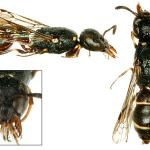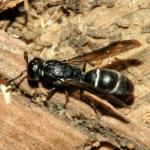Identification keys and general biology are given in Danks (1971), Spradbery (1973), Richards (1980) Yeo & Corbet (1995) and Archer (2000).
Introduced to the British list by Jones (1937) from Hampshire. The species is currently distributed from Dorset to Kent, north to Herefordshire, Warwickshire and West Norfolk.
Overseas found in many parts of Europe (including The Netherlands, Belgium, France, Spain, Portugal, Germany, Italy, Poland, Austria, Hungary, Greece).
Listed as Notable B by Falk (1991). [Now known as Scarce (Nb)].
Found in a wide variety of open habitats: woodland, parkland, gardens, heathland edge, chalk downland, gravel pits and coastal sites.
Univoltine; usually found during June and July, sometimes during August and rarely during September.
Weevil (Curculionidae) larvae.
A tube-dweller nesting in small beetle holes in dead wood, including old fence posts, and sometimes in bramble stems. Danks (1991) described a nest consisting of six linear cells with an outer plug of fine pith and fairly coarse sand grains. The outer four cells produced males and the inner two cells produced females. A female has been observed carrying a mud pellet in the mandibles, probably used to form the partitions between the cells.
Hawk's-beard, hogweed and mayweed.
No British records found; overseas Kunz (1994) gives the chrysid wasp Chrysis gracillima Förster.
2001



